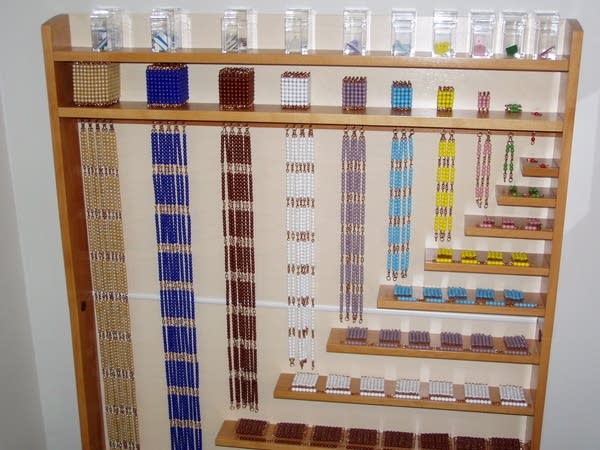Montessori education turns 100

The Montessori philosophy puts the child at the center of learning, not the teacher. Montessori schools encourage children to be independent, and to do things for themselves. Maria Montessori opened her first "Children's House" 100 years ago for the children of poor working parents in a Rome slum. She found that the children blossomed when surrounded by artwork, plants and light.
"There's three principles of these environments. Beauty, order and simplicity," said Molly O'Shaughnessy, who directs the Montessori Training Center in St. Paul.
At the training center, teachers learn the Montessori method in a practice classroom for three to six-year-olds. This classroom looks very different from a typical preschool. Tiny mops and brooms hang neatly from hooks on one wall. There's a small ironing board and miniature iron in another corner. And in the middle of the room, wooden shelves are filled with child-sized glass cups and pitchers.
O'Shaughnessy said Montessori begins with children learning to do domestic activities like sweeping, cleaning and preparing food.
Create a More Connected Minnesota
MPR News is your trusted resource for the news you need. With your support, MPR News brings accessible, courageous journalism and authentic conversation to everyone - free of paywalls and barriers. Your gift makes a difference.

"And you notice that we use glass, and it's beautiful, and it's color-coded. That's to help the child first carry things carefully, because they know they can break," O'Shaughnessy said.
Montessori educators say as children dust and wash, they develop motor skills, and learn that they're capable of doing things at home and at school. The method can seem strange to parents who weren't educated in Montessori schools. Paulette Zoe is principal of Lake Country School, a private Montessori school in Minneapolis with students from preschool through junior high. Zoe said one parent wondered why her son was doing housework.
"She was worried for the first six weeks that her child was being prepared for some kind of a career in the food service industry, because all he talked about was pickles for six weeks!" said Zoe. "And parents have said, you know, we're paying tuition for carrot-peeling?"
Zoe said food preparation provides sensory stimulation for children. As children get older, they learn language and math through Montessori materials, such sandpaper letters that children can trace and glass beads that help children visualize numbers.
In a classroom at Lake Country School, children ages six through nine are writing thank-you notes after a trip to the land school. Lake Country has a 160-acre farm in Wisconsin, where children can garden and care for animals.

Montessori schools group children of different ages together, so that younger children learn from older children. The school day is much more unstructured than traditional classrooms, and students are encouraged to follow their individual interests. Upstairs at the school, sixth graders are reading stories they've written to the fourth and fifth graders in their class.
"I feel a tug. No, not now! I beg. Please just let me get some sleep," reads Danielle Green. "But whatever supernatural power is controlling me doesn't listen, and I'm whisked off to another place, another time."
In Danielle's adventurous story, she is first a T-rex, then a soldier in World War II, then the first governor of Minnesota. Green and her classmates wrote themselves into history in stories that were supposed to explain their "cosmic task" - their purpose in life. Green said her task is to be a journalist, while another student wants to give health care to people who don't have health insurance.
Montessori educators say students from Montessori schools often go into professions that help other people, and they're good at collaborating with others. Molly O'Shaughnessy of the Montessori Training Center said the Montessori method is very different from traditional teaching, but she says it works.
"What we want to do is to show, to demonstrate, that Montessori works for all children. Because you will often hear, well, it works for children who come from wealthy backgrounds. Yes, it does," O'Shaughnessy said. "But it also works for children who come from very disadvantaged backgrounds."

Researcher Angeline Lillard found that Montessori students in Milwaukee outperformed their counterparts in traditional schools. Lillard, a psychology professor at the University of Virginia, compared inner-city children who attended Montessori schools to children in other schools.
"The five-year-olds did better on the Woodcock-Johnson tests that were about early school skills - reading and math," said Lillard. "The 12-year-olds were equivalent on those. The 12-year-olds did better on narrative essays and creativity of essays. They also did better on social skills and community orientation tests."
Lillard said she was skeptical when she first began her research, because few people in academic circles were talking about Montessori education. But she said she discovered that Maria Montessori was ahead of her time in figuring out that children learn best when they choose what they're studying, and when they work in peer groups.
Montessori education has now spread to more than 130 countries. In Minnesota, it's mainly taught in private schools, although a handful of public schools have Montessori classrooms. The Montessori Training Center plans to open a model school on the east side of St. Paul next year, which will include a museum and research center on the 100-year-old method.


